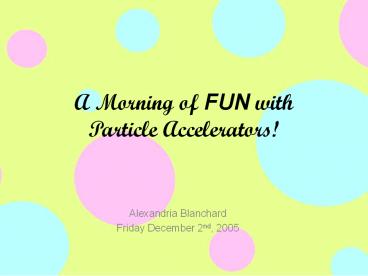A Morning of FUN with Particle Accelerators! - PowerPoint PPT Presentation
Title:
A Morning of FUN with Particle Accelerators!
Description:
Will there be proton accelerator backpack under the Christmas tree? At least not anytime soon... An idea great for a movie but not to hot for real life! ... – PowerPoint PPT presentation
Number of Views:135
Avg rating:3.0/5.0
Title: A Morning of FUN with Particle Accelerators!
1
A Morning of FUN with Particle Accelerators!
- Alexandria Blanchard
- Friday December 2nd, 2005
2
Outline
- Y Why this topic?
- Y Two types
- Linear particle accelerators
- Mini history lesson 1
- Fermi lab
- Guts of a LINAC
- Thumbs up and thumbs down
- Cyclotrons
- Mini history lesson 2
- Guts of a Cyclotron
- Yays and nays
- Y Applications
- Y Conclusion
3
I aint afraid of no ghosts!
- This presentation brought you through the
inspiration of the 1984 classic Ghostbusters
Egon- There's something very important I forgot
to tell you. Peter- What? Egon- Don't cross the
streams. Peter- Why? Egon- It would be bad.
Peter- I'm fuzzy on the whole good/bad thing.
What do you mean, "bad?" Egon- Try to imagine
all life as you know it stopping
instantaneously and every molecule in your body
exploding at the speed of light. Ray- Total
protonic reversal. Peter- Right. That's bad.
Okay. All right. Important safety tip. Thanks,
Egon.
4
How the linear particle accelerator came to life!
- R. Wideroe, in 1928, discovered that e- could be
accelerated through a tube with gaps through an
applied radio frequency voltage. - The LINear ACcelerator started off as a single
stage through direct current. The current could
be provided by a Van de Graaff generator
5
Fermi National Accelerator Laboratory Chicago,
Il.
- The most powerful proton-antiproton collider
- Designed to reach 1 TeV or 1012 eV
- Has produced evidence for the top quark
6
What makes the LINAC?
Ion source most common is a heated electrode (a
filament) if particle is
heavier, a proton, a hot cathode is used High
voltage source used for initial injection of
particles Hollow pipe vacuum chamber length
varies with application Radio-frequency
oscillators used to energize drift tubesDrift
tubes (or cylindrical electrodes) their length
varies with distance from the source, frequency
and power, the nature of the accelerated
particle Target varies with accelerated particle
and specific investigation Alignment magnetic
or electrostatic lens elements, use of servo
systems guided by laser beams the fact that
the tube is a Faraday cage.
7
s and s
- Accelerates heavy ions far better then ring
accelerators - Close to getting e- to relativistic speeds
- Produces a nearly continuous stream of
particles - - Length limits possible locations and
- - Accelerating cavity material limitations
8
the next step ?
9
Cyclotron ahoy
- The first successful cyclotron came from Earnest
Lawrence (1930) and accelerated protons with a
radio frequency voltage. - This model had a .1 m diameter!!!
- Not to long after Lawrence, with the assistance
of M. Stanley Livingston, created another with a
diameter or .25 m accelerated a proton to 1MeV.
10
What makes the Cyclotron?
- High-frequency alternating voltage applied
across the D or Dee electrodes - the frequency depends on particle mass
- Dee electrodes located in a flat vacuum chamber,
there is a small gap separating each electrode. - Ion source located in the Dee gap, center of
circle. Same dependencies as the LINAC. - M-field travels down through the top
- of the Dee
- Magnet creates a uniform m-field
- Deflector guides ion beam to the target
- Target same dependencies as the
- LINAC
11
Ooo, pretty physics equation time
- Fmagq(vxB)
- Fca(mv2)/r (mv2)/rq(vxB)
- FcaFmag v/r(qB)/m
- w(qB)/m fw/(2pi)
-
f(Bq)/(2mpi) -
12
s and s
- Saves and power
- Continuous stream of particle pulses
- Compact
- Radiation energy waste no more
- - Big odd shaped vacuum chamber
13
Applications!
polymerize plastics treat waste sterilize food
precise cancer treatment isotope
production nuclear energy atmospheric
understanding
14
Will there be proton accelerator backpack under
the Christmas tree?
Lets see Your not tall enough for a LINAC. both
are pretty darn heavy! (might want to
bulk up a little)Humans were rather susceptible
to radiation last time I checked To obtain
the full effects you need to live in a
vacuum An idea great for a movie but not to
hot for real life!!!
At least not anytime soon Dont cry, I bet
youll get something cool anyways!
15
Bibliography
A Proton Accelerator in Brief. MYRRHA.
http//www.sckcen.be/myrrha/MYRRHA/accel.php
Accelerator applications. http//www.madrimasd.o
rg/cienciaysociedad/ateneo/dossier/particulas/cern
/public_web_cern_ch/Public/accelerators/applicatio
ns.html Accelerators. HyperPhysics.
http//hyperphysics.phy-astr.gsu.edu/hbase/hframe.
html Circular Accelerator. Stanford.
http//www2.slac.stanford.edu/vvc/accelerators/cir
cular.html Cyclotrons. Wikipedia.
http//en.wikipedia.org/wiki/Cyclotron High
Intensity Proton Accelerator Project. Shinya
Sawada. http//www.slac.stanford.edu/econf/C010630
/papers/E506.PDF Knight, Randall D. Physics for
Scientists and Engineers. San Francisco Pearson
Education, Inc., 2004. Large Storms on Earth are
Particle Accelerators. Slashdot.
http//science.slashdot.org/article.pl?sid05/02/2
0/2323200tid14 Linear Accelerators. Radiology
Info. http//www.radiologyinfo.org/content/therapy
/linear_accelerator.htm Linear Accelerators.
Wikipedia. http//en.wikipedia.org/wiki/Linear_acc
elerator
16
Questions? Comments?































